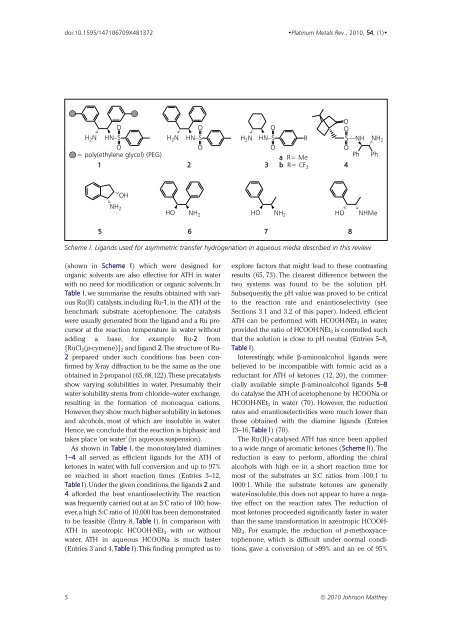Download Issue PDF - Platinum Metals Review
Download Issue PDF - Platinum Metals Review
Download Issue PDF - Platinum Metals Review
Create successful ePaper yourself
Turn your PDF publications into a flip-book with our unique Google optimized e-Paper software.
doi:10.1595/147106709X481372<br />
•<strong>Platinum</strong> <strong>Metals</strong> Rev., 2010, 54, (1)•<br />
O<br />
O<br />
O<br />
O<br />
O<br />
H 2 N HN–S<br />
H 2 N HN–S<br />
H 2 N HN–S R<br />
S––NH<br />
O<br />
O<br />
O<br />
= poly(ethylene glycol) (PEG)<br />
a R= Me<br />
O<br />
Ph<br />
1 2 3 b R= CF 3<br />
4<br />
NH 2<br />
Ph<br />
NH 2<br />
OH<br />
HO NH 2 HO NHMe<br />
5<br />
6<br />
HO NH 2<br />
7<br />
8<br />
Scheme I. Ligands used for asymmetric transfer hydrogenation in aqueous media described in this review<br />
(shown in Scheme I) which were designed for<br />
organic solvents are also effective for ATH in water<br />
with no need for modification or organic solvents. In<br />
Table I, we summarise the results obtained with various<br />
Ru(II) catalysts, including Ru-1, in the ATH of the<br />
benchmark substrate acetophenone. The catalysts<br />
were usually generated from the ligand and a Ru precursor<br />
at the reaction temperature in water without<br />
adding a base, for example Ru-2 from<br />
[RuCl 2 (p-cymene)] 2 and ligand 2.The structure of Ru-<br />
2 prepared under such conditions has been confirmed<br />
by X-ray diffraction to be the same as the one<br />
obtained in 2-propanol (65,68,122).These precatalysts<br />
show varying solubilities in water. Presumably their<br />
water solubility stems from chloride–water exchange,<br />
resulting in the formation of monoaqua cations.<br />
However,they show much higher solubility in ketones<br />
and alcohols, most of which are insoluble in water.<br />
Hence, we conclude that the reaction is biphasic and<br />
takes place ‘on water’ (in aqueous suspension).<br />
As shown in Table I, the monotosylated diamines<br />
1–4 all served as efficient ligands for the ATH of<br />
ketones in water, with full conversion and up to 97%<br />
ee reached in short reaction times (Entries 3–12,<br />
Table I).Under the given conditions,the ligands 2 and<br />
4 afforded the best enantioselectivity. The reaction<br />
was frequently carried out at an S:C ratio of 100; however,a<br />
high S:C ratio of 10,000 has been demonstrated<br />
to be feasible (Entry 8, Table I). In comparison with<br />
ATH in azeotropic HCOOH-NEt 3 with or without<br />
water, ATH in aqueous HCOONa is much faster<br />
(Entries 3 and 4, Table I).This finding prompted us to<br />
explore factors that might lead to these contrasting<br />
results (65, 73). The clearest difference between the<br />
two systems was found to be the solution pH.<br />
Subsequently, the pH value was proved to be critical<br />
to the reaction rate and enantioselectivity (see<br />
Sections 3.1 and 3.2 of this paper). Indeed, efficient<br />
ATH can be performed with HCOOH-NEt 3 in water,<br />
provided the ratio of HCOOH:NEt 3 is controlled such<br />
that the solution is close to pH neutral (Entries 5–8,<br />
Table I).<br />
Interestingly, while β-aminoalcohol ligands were<br />
believed to be incompatible with formic acid as a<br />
reductant for ATH of ketones (12, 20), the commercially<br />
available simple β-aminoalcohol ligands 5–8<br />
do catalyse the ATH of acetophenone by HCOONa or<br />
HCOOH-NEt 3 in water (70). However, the reduction<br />
rates and enantioselectivities were much lower than<br />
those obtained with the diamine ligands (Entries<br />
13–16, Table I) (70).<br />
The Ru(II)-catalysed ATH has since been applied<br />
to a wide range of aromatic ketones (Scheme II). The<br />
reduction is easy to perform, affording the chiral<br />
alcohols with high ee in a short reaction time for<br />
most of the substrates at S:C ratios from 100:1 to<br />
1000:1. While the substrate ketones are generally<br />
water-insoluble, this does not appear to have a negative<br />
effect on the reaction rates. The reduction of<br />
most ketones proceeded significantly faster in water<br />
than the same transformation in azeotropic HCOOH-<br />
NEt 3 . For example, the reduction of p-methoxyacetophenone,<br />
which is difficult under normal conditions,<br />
gave a conversion of >99% and an ee of 95%<br />
5 © 2010 Johnson Matthey
















